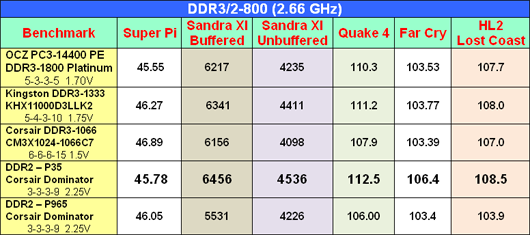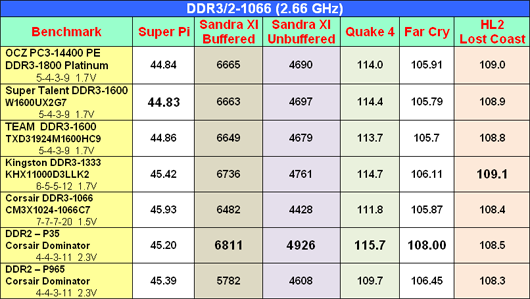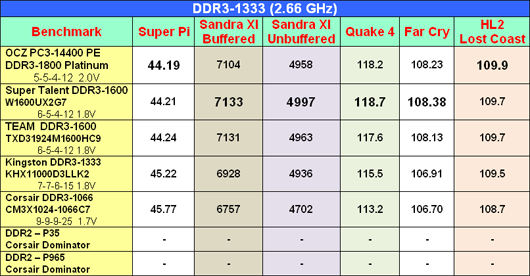DDR2/DDR3 Overlap Speeds
In Kingston Launches Low-Latency DDR3, memory performance was compared at the DDR2 and DDR3 overlap speeds of 800 and 1066 MHz. With the retesting of memory in the new test bed it was worthwhile to compare memory, at least in this initial review, at the overlap speeds. This presents the opportunity of seeing how top DDR3 performance compares to the DDR2 performance with which you are familiar.
At 800 MHz, DDR2 is capable of 3-3-3 timings, while DDR3 is limited to CAS 5 in the ASUS P5K3 Deluxe BIOS. With that severe timing limitation, which is the result of the much higher speeds available with DDR3, the DDR2 memory is generally the fastest solution. The latest Elpida (Kingston) and Micron Z9 (OCZ) chips still beat the last generation DDR2 in the Intel P965 motherboard in almost every case. However, the latest P35 Intel chipset driving DDR2 instead of DDR3 is still the best performer at 800 MHz - simply due to the advantage of CAS 3 compared to CAS 5 timings.
At the overlap speed of 1066 DDR2 still enjoys a timings advantage over DDR3 on the ASUS board. The fastest DDR3 CAS timings of 5 limits the best DDR3 timings to 5-4-3 compared to DDR2 at 4-4-3 with Corsair Dominator DDR2. Even with the timings advantage, DDR2 is only truly the better performer when running on the P35 chipset. The advantage for DDR2 here is very small to non-existent, however, as DDR3 results top a couple of the P35 DDR2-1066 benchmarks and the Elpida and Micron Z9 generally outperform DDR2/P965 across the board.
By 1333 the timing advantage for DDR2 is gone and DDR3 pulls clearly in the lead in all benchmarks. The Micron Z9-based memories top the 1333 performance charts in all benchmarks, and this is just the beginning of a range that extends to DDR3-2000 and beyond for some of these memories. Keep in mind that memory in these three charts are all running at the same 2.66GHz CPU speed, and that only the memory speed has been changed by varying ratios. It should be obvious in these results why Intel elected to move to the 1333 bus and the faster speeds of DDR3 memory.
Going up from DDR3-1333 to DDR3-1600, DDR3-2000 and beyond further extends the performance lead for DDR3 as you will see in the next three pages of DDR3 performance results on the same benchmarks. With the change to the 3.0GHz processor speed to allow memory tests through DDR3-2000 at the same CPU speed, all benchmarks were rerun at the 3.0GHz CPU speed with 800, 1066, and 1333 memory speeds. This allows a linear comparison of DDR3 memory at all available memory speeds while the CPU speed remains at a constant 3.0GHz.
For this and subsequent DDR3 reviews, DDR3 performance will be compared at 800, 1066, 1333, 1600, 2000, and the highest memory speed for the tested memory. 1000 is the logical base for the 333 strap, as is 1666, but current ratios limit realistic benchmarking to the 1066 and 1600 reference speeds. We will change to the 1000 and 1666 speed options as soon as available memory ratios in the BIOS allow a more convenient means to select 1000 and 1666 as memory speeds at a consistent processor speed. Those ratios are not currently available in the ASUS P5K3 Deluxe BIOS - or in any other DDR3 compatible motherboards at present.
In Kingston Launches Low-Latency DDR3, memory performance was compared at the DDR2 and DDR3 overlap speeds of 800 and 1066 MHz. With the retesting of memory in the new test bed it was worthwhile to compare memory, at least in this initial review, at the overlap speeds. This presents the opportunity of seeing how top DDR3 performance compares to the DDR2 performance with which you are familiar.
 |
| Click to enlarge |
At 800 MHz, DDR2 is capable of 3-3-3 timings, while DDR3 is limited to CAS 5 in the ASUS P5K3 Deluxe BIOS. With that severe timing limitation, which is the result of the much higher speeds available with DDR3, the DDR2 memory is generally the fastest solution. The latest Elpida (Kingston) and Micron Z9 (OCZ) chips still beat the last generation DDR2 in the Intel P965 motherboard in almost every case. However, the latest P35 Intel chipset driving DDR2 instead of DDR3 is still the best performer at 800 MHz - simply due to the advantage of CAS 3 compared to CAS 5 timings.
 |
| Click to enlarge |
At the overlap speed of 1066 DDR2 still enjoys a timings advantage over DDR3 on the ASUS board. The fastest DDR3 CAS timings of 5 limits the best DDR3 timings to 5-4-3 compared to DDR2 at 4-4-3 with Corsair Dominator DDR2. Even with the timings advantage, DDR2 is only truly the better performer when running on the P35 chipset. The advantage for DDR2 here is very small to non-existent, however, as DDR3 results top a couple of the P35 DDR2-1066 benchmarks and the Elpida and Micron Z9 generally outperform DDR2/P965 across the board.
 |
| Click to enlarge |
By 1333 the timing advantage for DDR2 is gone and DDR3 pulls clearly in the lead in all benchmarks. The Micron Z9-based memories top the 1333 performance charts in all benchmarks, and this is just the beginning of a range that extends to DDR3-2000 and beyond for some of these memories. Keep in mind that memory in these three charts are all running at the same 2.66GHz CPU speed, and that only the memory speed has been changed by varying ratios. It should be obvious in these results why Intel elected to move to the 1333 bus and the faster speeds of DDR3 memory.
Going up from DDR3-1333 to DDR3-1600, DDR3-2000 and beyond further extends the performance lead for DDR3 as you will see in the next three pages of DDR3 performance results on the same benchmarks. With the change to the 3.0GHz processor speed to allow memory tests through DDR3-2000 at the same CPU speed, all benchmarks were rerun at the 3.0GHz CPU speed with 800, 1066, and 1333 memory speeds. This allows a linear comparison of DDR3 memory at all available memory speeds while the CPU speed remains at a constant 3.0GHz.
For this and subsequent DDR3 reviews, DDR3 performance will be compared at 800, 1066, 1333, 1600, 2000, and the highest memory speed for the tested memory. 1000 is the logical base for the 333 strap, as is 1666, but current ratios limit realistic benchmarking to the 1066 and 1600 reference speeds. We will change to the 1000 and 1666 speed options as soon as available memory ratios in the BIOS allow a more convenient means to select 1000 and 1666 as memory speeds at a consistent processor speed. Those ratios are not currently available in the ASUS P5K3 Deluxe BIOS - or in any other DDR3 compatible motherboards at present.










25 Comments
View All Comments
Lonyo - Tuesday, July 31, 2007 - link
Any chances of a power consumption comparison between DDR2 and DDR3?DDR3 is supposed to run at a lower voltage, so in theory it might use a little less power. Would be interesting to see if there is any difference (DDR2/3-800 would probably be best, since that's a standard speed for both).
yyrkoon - Tuesday, July 31, 2007 - link
Does anyone even sell a DDR3 capable motherboard yet ? If so, is anyone even using DDR3 ? Personally, I think latencies need to come down, Prices need to come down,etc. Memory companies are *claiming* they are taking a beating in the market for DDR2 (claiming all time low, and losing money . . .).Personally, I think you reap what you soe, and they got what they deserved for their early market prices.Anyhow, short and skinny, I think *we* all need to take things slowly this time around, OEMS, buyers, and reviewers . . .
yyrkoon - Tuesday, July 31, 2007 - link
By the way, when I asked if anyone is even making a DDR3 motherboard yet, I was pretty much joking. Obviously if you're testing it, there has to be some form of a platform availible.You know, I cannot help but think that DDR2 was not quite 'finished' yet, and I do not understand the *need* for DDR3(unless OEMs are looking to rape our wallets again . . .). Of course, if 'Joe blow enthusiast' HAS to HAVE DDR3 memory because it gives him/her an extra 4-13 FPS in an outdated game at 2-3x the cost of DDR2 . . . well... lets just say that I expect that OCZ, Geil, and the rest would be more than happy to keep you poorer ;)
Some of us actually like to upgrade smart, using as many parts from older machines as possible to save money for other things. This sort of marketing strategy makes it hard on us who would like to do so while keeping our system upgraded once a year or so. I just got over having to buy memory, CPU, and a motherboard the last 'technolgy' advance, and I really do not wish to repeat the process.
asliarun - Tuesday, July 31, 2007 - link
Man, I never understand viewpoints such as yours. This is a technology article on the latest DDR3 advancement, and is not marketing propoganda urging you to go out and buy it NOW. Intel's latest CPU chipsets (P35/P38, IIRC) all support DDR3 (along with DDR2), so it's not like DDR3 is exactly vaporware. Only AMD is not supporting DDR3 right now because firstly, they will need to upgrade their integrated uncore memory controller, and secondly, they tend support upcoming technologies much later than Intel. Furthermore, DDR3 is definitely the future as it has much more headroom than DDR2, and is designed to work at lower voltages.In any case, my point is that we're discussing a new memory standard technology which is already in the market and is slowly being adopted. Initially, it WILL be highly priced like any other technology until volume manufacturing kicks in. However, if you are a price sensitive customer instead of a "Joe blow enthusiast" (frankly, like most of us), no one is forcing you to replace your RAM with DDR3 TODAY, least of all this AT article. Your logic of not adopting DDR3 simply because it is initially expensive and because it only gives "4-13fps increase" is however, absurd. By the same token, there is no need for ANY technology improvement, especially those that *only* result in an incremental improvement.
As a footnote, you should be grateful for all the "Joe blow enthusiasts" in this world instead of heaping scorn on them. All said and done, you and I ARE freeloading on him, as he's the one who's financing our cut rate technology purchases.
GlassHouse69 - Tuesday, July 31, 2007 - link
Oh you think so?hm.... i wonder how much Anandtech/daily got for reviewing this... hm.....